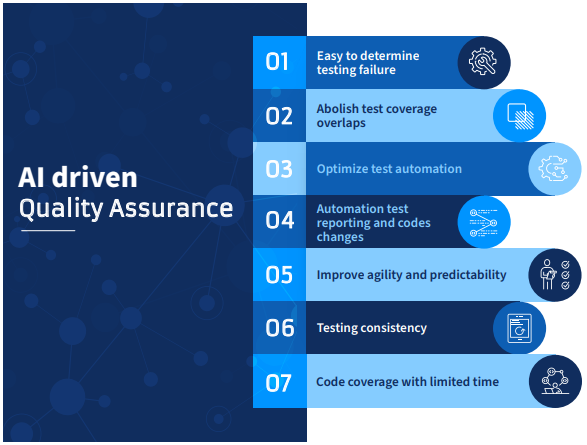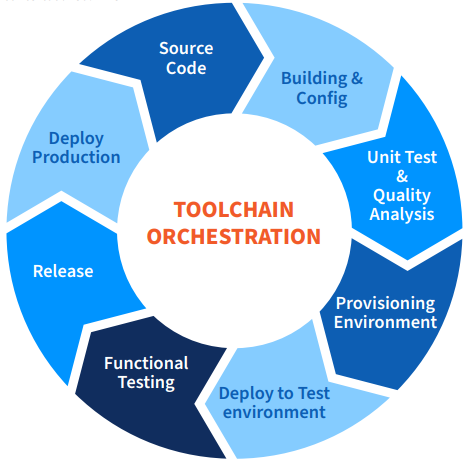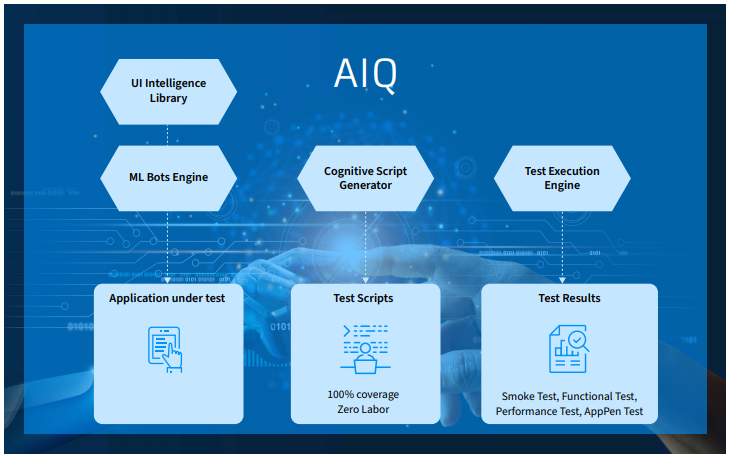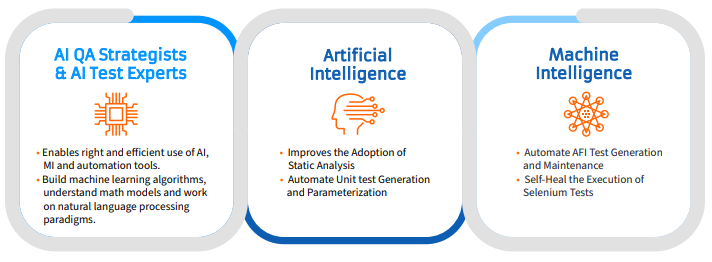Meeting the challenge of software quality
A test-driven development approach with continuous quality assurance embedded in an agile environment helps businesses meet the fast-paced demands of customers and remain competitive through faster time to market.
The power of artificial intelligence, combined with the right automation approach, will further enhance the testing ecosystem by making it not only continuous, but autonomous.
Introduction
This whitepaper will provide some of the key success parameters for the dynamic digital age that are critical for businesses to keep up with the speed to market and deliver value to customers. These strategies require IT groups to be more nimble and agile than ever before to accommodate adjustments in enterprise priorities and ship better quality products within shorter timeframes.
DevOps, the Agile exercise that builds velocity by fostering collaboration, is quickly turning into the default model of software program delivery. It helps drive automation throughout the software delivery lifecycle (SDLC) which enables faster turnaround in response to changing market requirements. Despite this emphasis on speed, quality needs to be at the center of the software development process. It makes a strong business case to have an enhanced strategy for an embedded test and quality driven development.
We call it the “Quality First” approach. This paper will bring out some of the challenges in accomplishing this, and will provide viable answers to overcome these issues. It also covers options organizations have to meet their quality agenda.
Shifting quality strategy to catch up with rapid development
According to the Everest Group report “Quality Orchestration: QA for the Digital Era,” 57% of surveyed organizations stated they have a roadmap to implement a DevOps project, while 34% declare to be scaling up their DevOps programs.
Embedding quality assurance (QA) in DevOps offers the opportunity for non-stop integration, which rapidly ensures code modifications are added correctly and efficiently.
Moreover, non-stop “checking-out” and “checking-in” of code throughout the development life cycle needs to be backed by ensuring sound quality at an exceptional speed. However, this approach always has to deal with bottlenecks, such as siloed automation, unclear requirements, excessive testing volumes, nonstandard reporting, manual intervention at critical points, and other issues.
There is a need for a productized solution for testing that is AI-enabled and available over the Cloud for easy adoption, customization and scalability. The endeavor should be to orchestrate quality across the continuous testing pipeline by enabling autonomous testing using low-code or no-code configurations and advanced technology.
This white paper recommends methods of dealing with some of the challenges mentioned earlier and conceptualizes a productized way to manage testing by means of leveraging best-in-class technology and bringing standardization and predictability.
The following are the major components of a productized testing package via a standard platform, which forms the scope of this paper:
- Enabling AI in Quality Assurance
- Leveraging a QA Technology Kit to Enable Continuous Testing
- Adopting Standardized Test Management, Processes and Metrics
- Blending Human and Machine Intelligence
- Reducing Cost and Improving Efficiency
1. Enabling AI in quality assurance
Though most QA activities tend to run via automation these days, the code still has to be manually signed-off based on test results. This siloed automation, also known as automation lakes, produces an accordion effect, or a disrupted flow of elements due to the stagnation in the pipeline. Moreover, the functional and non-functional test scenarios are built manually. On top of that, one standard reporting mechanism does not help with the quality monitoring process. In summation, although we do see robust use of automation tools in software testing, the overall ecosystem is still far from being autonomous.
AI can boost the efficiency in the continuous testing process by reducing or eliminating manual intervention.
With an AI-powered testing approach, QA teams can trigger unattended test cycles where defects are identified and recovery measures are triggered at run time, based on insights gleaned from historical data points and the related events. Following this approach, the AI engine will make sure that only sturdy code progresses from one stage to the next, orchestrating the best quality throughput during entire development lifecycle.

Benefits earned from an AI-enabled QA platform include:
- Reduced test fatigue
- Extended traceability
- Test suite optimization
- Test scenario mining
- Business process assurance
- Predicting improvement points
- Better knowledge management
- Cost optimization
2. Leveraging QA technology kits to enable continuous testing
Every domain need and development work is exclusive, and therefore all IT and business needs should be contextualized. This includes appropriate tool choice, particularly for QA, which is a tool-intensive activity. For instance, anytime the developer commits a change within the code base, the QA groups leverage completely different tools to validate the code for various aspects like core functionality, performance, security, and scalability. For example, on occasions for managing pipelines for CI/CD, Jenkins may be better than Concourse.
Additionally, several tools required for test execution and management of scripts and other assets require careful selection. Losing focus on standardization at this point can cause a huge technical debt within the organization, and maintaining test assets becomes a complete nightmare.

3. Adopting standardized test management, processes, and metrics
Test management practices are everything that testers and QA teams do to manage the software testing process or lifecycle. Test case management tools enable software testers and QA teams to manage test case environments, automate tests, bugs and project tasks.
The structural quality of software is usually hard to manage. It relies mostly on the expertise of the engineering team and assurance via code review, analysis, and refactoring. At the same time, functional aspects are quality controlled through a set of dedicated quality management activities. Despite a common goal of delivering a product of the best possible quality, both structurally and functionally, QA teams take different approaches to manage this task.
As each team or unit uses their choice of tools, platforms, and reporting mechanisms, there will be a lack of a standard way in which the QA outcomes are measured and evaluated. A non-standard approach toward QA across an organization becomes an expensive affair.
The following are the two possibilities with non-standardized way:
- Quite a lot of handovers and takeovers take place between QA and Dev teams, and things go down to the wire always. Go-live dates are always at risk.
- QA metrics will be confusing and determining the exact ROI is difficult to establish. Other quality parameters become difficult to visualize for various projects.
Standardizing the QA process ensures uniformity across the development phases eliminates the possibility of confusion, prevents chaos, and yields the desired outcomes.

4. Blending human and machine intelligence
According to a report published by Everest Group, one can clearly infer that some of the key reasons for not being able to drive quality effectively are ineffective process orchestration, lack of industry and domain knowledge, and a lack of technical knowledge within the QA group.
To ensure quality software deliverables, consider adopting a standard productized approach for testing and leveraging best-in-class technology, process and AI. At the same time, all these assets should perfectly blend with excellent quality QA professionals. This right blend of humans and machines will drive quality results. The following are the traits of QA professionals that we highly recommend:
- Excellent domain knowledge to be able to understand customer needs. Sound domain knowledge helps provide the right approach towards testing by identifying the key business areas and plan test coverage accordingly.
- Sound orchestration of reporting and process adherence to be able to drive predictability and visibility at each step.
- Good technical knowledge always enables right and efficient use of available tools like low-code or no-code scripting, AI and automation tools, integration with DevOps, and many other benefits.
- Full stack quality engineers are a very important aspect of current testing world. As the world is moving towards agile development in integrated manner, the traditional ways of sound requirement documentation to envision testing are long gone. Therefore, a QA should be very knowledgeable around the technical know-how to be able to contribute effectively during development sprints.

5. Reducing cost and improving efficiency
As quality is at the center for continuous and autonomous testing, the focus of quality assurance is elevated to much higher levels and great expectations. Accomplishing these objectives is possible by using a variety of approaches around using best-in-class tools, the right QA engineers, standardized test management practices, and AI.
With all the right blend of technology and domain experience, QA teams can ensure businesses stay resilient, and are efficient and scalable at all times while operating at optimal cost.
Establishing Roadmap and Execution Approach
Before leveraging innovative technology, trained staff, and AI in the digital QA world, it is imperative that organizations need to invest in technology and training. The QA engineers need to think and approach the testing proposition with a much different mindset. The right understanding of customer’s expectation and accessibility of resources in standardized way will hold the key to success. Choosing the right technology stack for your enterprise level testing solution is a mammoth task, and having a qualified team to keep enhancing and supporting the solution becomes even more challenging.
Some of the common execution challenges are as follows:
- Understandability and interpretability of AI models
- Lack of specifications and defined requirements
- Need for validation data and test input generation
- Accuracy and correctness measures
- Non-functional properties of AI-based systems
- Self-adaptive and self-learning characteristics
- Dynamic and frequently changing environments.
Organizations have the following options to consider to overcome these challenges:
- Have in-house end-to-end capability
- Outsource to a qualified partner
- Take a hybrid and gradual approach
In-house solutions always provide better control on developing solutions for custom business needs, but comes with upfront costs, maintenance costs, and staffing challenges. Therefore, it provides a compelling value proposition from both speed and cost point of view to explore the opportunities to engage with right partner and have a clearly defined roadmap towards making the entire QA ecosystem productized. Organizations do not have to do this all on their own or all at once.
Exploring commercially viable pre-built offering that helps take hybrid and gradual steps helps the enterprise maximize profits and reduce TCO keeping the risk low.
Quality First, Quality Forever
To overcome legacy-testing methodologies with heavy overheads and high upfront cost, typically designed for traditional software development methods, and move into a more strategic, nimble, cost-effective and innovative digital reality requires adopting best-in-class testing platforms to make the QA process not only continuous, but also autonomous. This methodology may be adopted on a project basis or at the enterprise level as part of a strategic transition, with the help of a qualified partner who understands your industry.
EXL has the insurance and healthcare domain experience, technology expertise, and proven partnerships in place now to implement an enterprise-wide QA platform and processes that fits your specific needs going forward. Our best-in-class productized testing solutions provide capabilities that are easily implemented, customizable, easy to adopt, and carry low maintenance costs. The overall solution is scalable to maximum test coverage and delivers quality solutions to the end user. This solution is bundled with our highly capable and talented QA engineering team with great domain knowledge.
Achieve the agility, savings and customer-centricity you need to grow during trying times. Explore a comprehensive offering that can accelerate your quality assurance transition journey. Connect with EXL and start a discussion today.
Written by
Megha Dalela
Vice President, Global Products and Platform,
Insurance & Healthcare Pronay Chakraborty
Development Manager, Global Products and Platform,
LifePRO® & LDS
